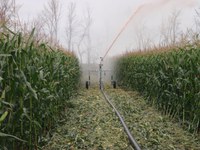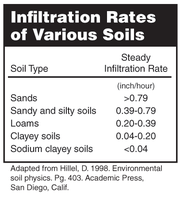Reduce Containment Pond Levels in Wet Years
(Click an image below to view a high-resolution image that can be downloaded)
Containment ponds in livestock manure storage systems are designed to collect runoff and lose water to evaporation.
“However, during wet years, containment ponds periodically need to be emptied due to being overfilled,” says Chris Augustin, nutrient management specialist at North Dakota State University’s Carrington Research Extension Center. “Overfilling may lead to a surface water discharge that can cause environmental issues and erode away the pond.”
The pond may require extensive dirt work if it does erode. Augustin recommends applying pond effluent to crop or pastureland to prevent the containment pond from overfilling. The effluent also can serve as an irrigation source.
High pond levels likely occur during the spring thaw, but finding a suitable application site during the spring can be difficult. Saturated soils are common, which can increase runoff risks. The best time to manage a containment pond is during the summer, when evaporation is greatest and soils tend to be the driest.
“Remember, apply containment pond effluent at rates less than a soil’s infiltration rate,” Augustin advises.
The soil’s infiltration rate predominately is determined by soil texture and topography. Finer-textured soils, such as clay, will allow liquid to infiltrate more slowly than coarsely textured soils. Soil compaction from field equipment traffic or naturally occurring from sodium-soil horizons can lower soil infiltration rates. Water infiltration is fast on dry soil but slows as it saturates and approaches field capacity.
Slopes affect soil infiltration rates because of runoff. Steep slopes increase runoff, whereas shallow slopes have less runoff. Augustin recommends applying effluent in areas with less than a 6 percent slope.
“Also, be careful when applying containment pond effluent near surface waters,” he says. “The effluent cannot be applied closer than 100 feet to a down-gradient surface water, open tile line intake structures or well heads.”
The effluent must be applied to meet crop nutrient needs. Small amounts of nutrients can be found in containment pond effluent.
Most of the nutrients found in manure are in an organic form unavailable to plants (immobilized). Once converted to a plant-available form (mineralized), manure or effluent can supply crops with nutrients.
Nitrate, a mineralized nitrogen form, is water-soluble and moves readily with water, whereas phosphorus attaches to a soil particle and moves through runoff. Excess nitrogen and phosphorus in surface water can cause algae blooms and lower water quality. However, excess potassium in surface water does not cause adverse water quality effects.
“Proper containment pond management is an important piece in a nutrient management plan,” Augustin says. “Utilizing effluent water as an irrigation source is a good use while lowering containment pond levels.”
NDSU Agriculture Communication - June 28, 2011
| Source: | Chris Augustin, (701) 652-2951, chris.augustin@ndsu.edu |
|---|---|
| Editor: | Ellen Crawford, (701) 231-5391, ellen.crawford@ndsu.edu |




